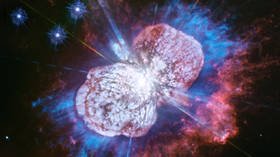Hubble captures double-star system’s spectacular cosmic fireworks (IMAGE)

A fascinating double-star system that’s been exploding for two centuries has been captured in stunning never-before-seen detail by Hubble, the groundbreaking space telescope.
Hubble has been capturing the Eta Carinae double-star system for over two decades, giving astronomers unprecedented insights into the system’s evolution and changing characteristics over time.
Located 7,500 light-years away, Hubble has observed the system in various wavelengths. Its latest observation, however, shows the system in unprecedented detail with the highest resolution image ever taken.
The spectacular display was created using Hubble’s Wide Field Camera to map warm magnesium gas glowing in ultraviolet light (seen in blue in the above image).

Eta Carinae violently exploded in the 1840s in what is known as the ‘Great Eruption,’ throwing gas and dust into space in an incredible display of slow-motion fireworks that hasn’t stopped since.
The causes of the eruption remain a point of speculation and debate among the scientific community. Which is precisely why the system has been monitored by almost every instrument on Hubble over more than 25 years.
Also on rt.com This strange galaxy is defying the universe to travel towards the Milky Way (PHOTO)This newly revealed data is an important step in understanding how the eruption began, because it shows the fast and energetic ejection of material that may have been expelled by the star shortly before the expulsion of the rest of the nebula. However, astronomers still need more observations to measure exactly how fast the material is moving and when it was ejected.
Like this story? Share it with a friend!














